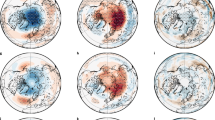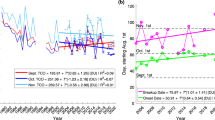Abstract
THE 1987 Antarctic Airborne Ozone Expedition established that the springtime depletion of Antarctic ozone1,2 is due to photochemical destruction3 following a preconditioning phase involving heterogeneous reactions on polar stratospheric clouds4. Ozone destruction is concentrated in the cold Antarctic stratospheric vortex of winter and early spring, where these clouds occur. Nevertheless, ozone data reveal a secular decline into mid-latitudes5,6. Modelling studies6,7 suggest a 'dilution effect' whereby ozone-poor air is transported into mid-latitudes when the vortex breaks up in late spring (the 'final warming'). The extent to which the effect penetrates into middle latitudes is clouded by statistical uncertainty in trend analyses and by the difficulty of separating photochemical and dynamical effects on seasonal timescales. Here we analyse record low ozone values found over Australia and New Zealand during December 19875 following the record low Antarctic values of October 19875. In fact, there was a sudden decline of ozone amounts in mid-month; this rules out photochemical effects as a cause and allows us to investigate the underlying processes on a 'case study' basis. Using data from ozonesondes, radiosondes, the Nimbus-7 total ozone mapping spectrometer (TOMS), and meteorological analyses from the National Meteorological Center (Washington), we argue that these low values resulted from transport of ozone-poor air from higher latitudes. It therefore seems that the chemical destruction of ozone over Antarctica in early spring is having an impact on lower latitudes.
Similar content being viewed by others
References
Farman, J. C., Gardiner, B. G. & Shanklin, J. D. Nature 35, 207–210 (1985).
Stolarski, R. S. et al. Nature 322, 808–811 (1986).
Anderson, J. et al. J. geophys. Res. (1989).
Toon, O. B., Hamill, P., Turco, R. P. & Pinto, J. Geophys. Res. Lett. 13, 1284–1287 (1986).
Atkinson, R. & Easson, J. in Proc. Inter. Ozone Symp. (eds Bojkov, R. & Fabian, P.) (A. Deepak, Hampton, Virginia, 1988).
Sze, N. D. et al. J. geophys. Res. (1989).
Prather, M. J. & Garcia, M. M. in Proc. Polar Ozone Workshop, Snowmass 1988 (NASA Conf. Publ. 10014, 1988).
Krueger, A. J., Schoeberl, M. R., Stolarski, R. S. & Sechrist, F. S. Geophys. Res. Lett. 15, 1365–1368 (1988).
Newman, P. A. Geophys. Res. Lett. 13, 1228–1231 (1986).
Randel, W. J. Geophys. Res. Lett. 15, 911–914 (1988).
Gardiner, B. J. Geophys. Res. Lett. 15, 901–904 (1988).
Newman, P. A. & Schoeberl, M. R. in Proc. Inter. Ozone Symp. (eds Bojkov, R. D. & Fabian, P.) (A. Deepak, Hampton, Virginia, 1988).
WMO, Atmospheric Ozone 1985, Global Ozone Research and Monitoring Project Report no. 16 (1985).
McIntyre, M. E. & Palmer, T. N. Nature 305, 593–600 (1983); J. atmos. terr. Phys. 46, 825–849 (1984).
Trenberth, K. E. & Olson, J. G. NCAR Tech. Note NCAR/TN-301+STR (1988); NCAR Tech. Note NCAR/TN-299+STR (1988).
Author information
Authors and Affiliations
Rights and permissions
About this article
Cite this article
Atkinson, R., Matthews, W., Newman, P. et al. Evidence of the mid-latitude impact of Antarctic ozone depletion. Nature 340, 290–294 (1989). https://doi.org/10.1038/340290a0
Received:
Accepted:
Issue Date:
DOI: https://doi.org/10.1038/340290a0
- Springer Nature Limited
This article is cited by
-
Ultraviolet-B and water stress effects on growth, gas exchange and oxidative stress in sunflower plants
Radiation and Environmental Biophysics (2008)
-
Human effect on global climate?
Nature (1996)





